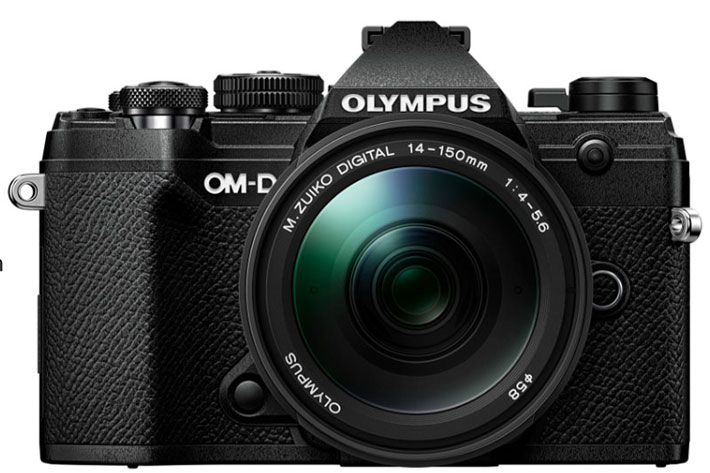
The new and lightweight Olympus OM-D E-M5 Mark III is more of a video machine than many would suspect: this compact Micro Four Thirds model true to Maitani’s spirit, captures DCI 4K video.
The same Olympus that not long ago introduced a professional camera, Olympus OM-D E-M1X, that is big and heavy, is now going back to its roots, with a small camera that Olympus says is “approximately 55% the volume of competitive full-frame mirrorless systems”. The value was, probably, defined before cameras as the Canon EOS RP appeared, as, in fact, there is not much difference between these models: the Olympus OM-D E-M5 Mark III has 125 x 85 x 50 mm and weights 414 g and the Canon EOS RP has 132.5x85x70 mm and weighs 440g.
https://youtu.be/G9pY14MMjdM
Still, no discussion here, the Olympus is a small camera, just not as small as the marketing seems to suggest. In fact, if the numbers I’ve for the previous model, Olympus OM-D E-M5 Mark II, are correct – dimensions of 123.7x85x38 mm – the OM-D E-M5 Mark III is a little bigger, although the Mark II is heavier, with 496g. Right? Just as a footnote that I deem important: even the Nikon Z50, another full frame sensor, is just 127 x 94 x 60mm with a weight of 450g.
All Olympus technology in a small body
Much of the technology found in the OM-D E-M1 Mark II professional model, appears in this compact, lightweight, weathersealed camera that includes a 20 megapixel Live MOS sensor, 5-Axis in-body Image Stabilization with up to 5.5 EV steps of compensation (6.5 EV steps with Sync IS), 30 frames per second sequential shooting, high speed and high precision autofocus capabilities using 121-point all cross-type on-chip phase detection AF, as well as versatile shooting features such as Live Composite and Focus Stacking and advanced features such as Cinema 4K Video and Pro Capture.
https://youtu.be/-lBbtBbj3uE
In an effort to deliver the smallest body possible it was necessary, says Olympus, to minituarize many components, including the image stabilization unit. Size also led to the choice of the more compact BLS-50 battery, which is possible, adds Olympus, because of “dramatic improvements in power-saving performance”, something users will have a chance to try in real world situations. Olympus says a battery will last for 310 shots, according to CIPA’s standard test.
No crop, DCI 4K movies
Video capture is present, as in previous models from Olympus, with the E-M5 Mark III supporting Cinema 4K video 24p, Full HD 30 fps, All-Intra and Full HD 60p. Information from the On-chip Phase Detection AF sensor is used for optimal focusing when recording video. With this, users can record 4K 30P high-definition video. Combining 5-Axis Image Stabilization with electronic stabilization make it possible to record stable video with minimal camera shake. No special stabilization equipment is required, even during active movement.
With many of the features available in the whole family of Olympus cameras, the E-M5 Mark III introduces USB charging for the battery on the move, which can be used when the camera is not in use. The Olympus OM-D E-M5 Mark III will be available in both black and silver in late November. The camera body only will have a suggested retail price of $1,199.99 and the camera body with the M.Zuiko Digital ED 14-150mm F4.0-5.6 II lens will have a suggested retail price of $1,799.99.
Key video features of the Olympus E-M5 Mark III
Maximum video recording time is approx. 29min 59sec, and the camera captures video on the full sensor, without crop. Video exposure control is available in Program AE, Aperture priority AE, Shutter priority AE and Manual. The camera has 4 types of grid lines / 4 colors for focus peaking, and allows for Live View output via HDMI.
- 4096×2160(C4K) / 24p / IPB(approx.237Mbps)
- 3840×2160(4K) / 30p, 25p, 24p / IPB(approx.102Mbps)
- 1920×1080(FHD) / 30p, 25p, 24p / ALL-I (A-I), IPB(SF, F, N)
- 1920×1080(FHD) / 60p, 50p / IPB(SF, F, N)
- 1280×720(HD) / 60p, 50p, 30p, 25p, 24p / ALL-I (A-I) , IPB(SF ,F ,N)
- 60p: 59.94 fps
- 50p: 50.00 fps
- 30p: 29.97 fps
- 25p: 25.00 fps
- 24p: 23.98 fps
- C4K 24.00 fps
FHD ALL-I(A-I : ALL-Intra/approx.202Mbps) FHD IPB(SF : SuperFine / approx.52Mbps, F : Fine / approx.30Mbps, N : Normal / approx.18Mbps)
HD ALL-I(A-I : ALL-Intra / approx.102Mbps) HD IPB(SF : SuperFine /approx.26Mbps, F : Fine / approx.14Mbps, N : Normal / approx.10Mbps)
The camera offers Art Filters and Movie Effects which, when in use, can affect frame rates, that will drop. A Class 10 or higher SD card is recommended for shooting movies with a UHS-II or UHS-I U3 card being recommended for 4K, C4K, ALL-I shooting.
